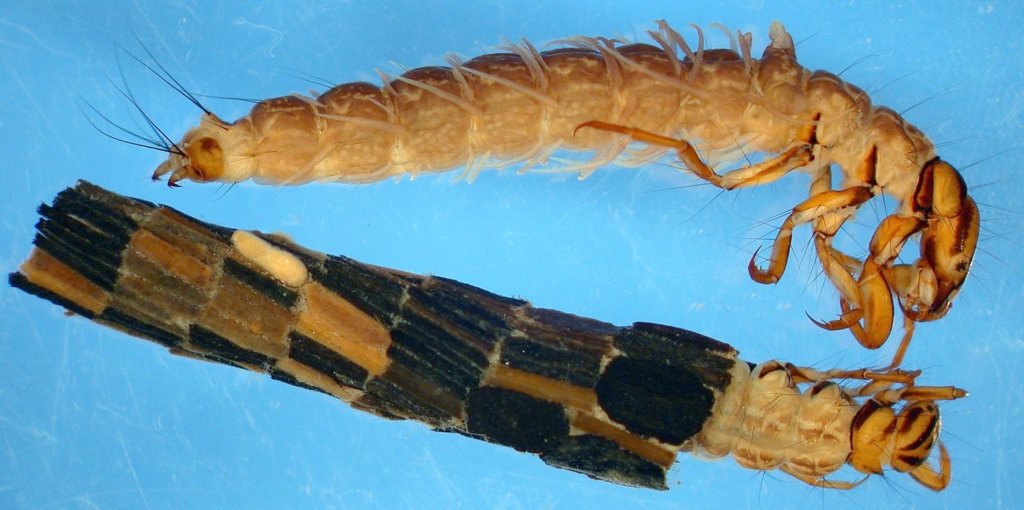Benthic Invertebrates; the Who, What, and Why
Friday Read and Science | benthic invertebrate and water | August 2022
Aneilia Ayotte, Science Communications Coordinator
What are benthic invertebrates?
Benthic Invertebrate sounds like a bit of a daunting phrase when you first hear it, however when you break it down it isn’t so bad. The word benthic is derived from the Greek word benthos which means “depth” or “bottom of the sea.” Invertebrate refers to any organism lacking a spine or backbone (Merriam-Webster’s Collegiate Dictionary, 1999). When these two words are put together, they describe any spineless organism that lives at the bottom of a water body such as a lake, river, stream, or even an ocean! These Benthic invertebrates may be fully grown, like a worm or a beetle, or they may be in their larval stages like stoneflies, mayflies, or caddisflies. These three different kinds of flies (Ephemeroptera, Trichoptera and Plecoptera) can also be referred to as the EPT. EPT are extremely important to understanding water body health!
Why are benthic invertebrates bottom dwellers?
- Benthic invertebrates normally live under or attached to rocks, sticks and other vegetation. They also burrow themselves into sand, dirt, and sediment. This protects them from predators and habitat disturbances (David Currie, 1996).
- Many of these invertebrates must be born in the water and spend most of their lives in it. When they reach their adult stage, they normally leave the aquatic environment and grow wings, however, some do not.
The EPT
As mentioned, mayflies, stoneflies and caddisflies can be grouped together into something known as the EPT. This title is given to them based off their scientific order. Ephemeroptera is the order name for mayflies, which gives the EPT its “E” (Integrated Taxonomic Information System, ITIS)! Plecoptera are stoneflies, and they start with a “P” (ITIS). Finally, caddisflies are represented by the “T,” as their order is Trichoptera (ITIS). EPT are important when looking at the health of water bodies because these flies are more sensitive to environmental change than other benthic invertebrates (Alberta Environment and Parks, 2014). The abundance of these benthic invertebrates can be influenced by many factors like: water temperature, water depth, dissolved oxygen concentrations, pH, salinity, and sedimentation (David Currie, 1996). Due to those factors, these three types of flies can be monitored to understand how healthy a body of water is. An abundance of these organisms indicates good environmental conditions.
Benthic Invertebrates and the AWC (Athabasca Watershed Council)
In 2021, the AWC conducted water testing in the Mcleod River, Gregg River, Solomon Creek, and Whitehorse Creek as part of the Upper Athabasca Watershed Biomonitoring project. As part of this project, water samples were taken to test pH, turbidity, water temperature, and dissolved oxygen. Gathering this data not only tells us about the water, but it provides information on what is living in it.
To learn more about this project, visit:
Not only does the AWC do water sampling to monitor these invertebrates, but we want others to learn about them too! That is why we hold events like pond days, to share the information we have gathered with various people. This way, many can learn about the importance of these little critters!
At the benthic invertebrate pond day that we had this summer, the kids were given nets and they were let loose on the shore of Chip Lake to find their own invertebrates. They brought them back to us and we put them in buckets to begin identifying them! Not only was this educational for the students, but it was a ton of fun to hang out with these benthic invertebrates up close!
Click here to see the EPT in action:
FUN FACT: Not only are benthic invertebrates a good indicator of healthy water, but they can help accelerate nutrient cycling by mixing up the sediment beneath the water!



This project is financially supported by Alberta Conservation Association.

